MGMT8045: Emirates Airline Success and Competitive Advantages
VerifiedAdded on 2022/09/22
|6
|1572
|26
Case Study
AI Summary
This case study analyzes the remarkable success of Emirates Airline, examining the factors that have contributed to its growth and competitive advantage in the global airline industry. The analysis begins with an overview of Emirates' establishment and rapid expansion, highlighting its strategic alignment with Dubai's vision to become a major hub for tourism and trade. The document explores key success factors, including the airline's focus on quality service, cost-efficient operations, and innovative strategies to adapt to market challenges. It delves into the application of Porter's Five Forces, resource-based view (RBV) strategies, and the use of corporate social responsibility (CSR) in marketing. Additionally, the analysis emphasizes the role of strong leadership, effective marketing, and the airline's strategic location in connecting the East and West. The conclusion summarizes the importance of selecting the right location and using effective strategies to gain a competitive advantage, ensuring the airline maintains its position in the market. This assignment is a valuable resource for students looking to understand the dynamics of strategic management and competitive advantage in the airline industry.
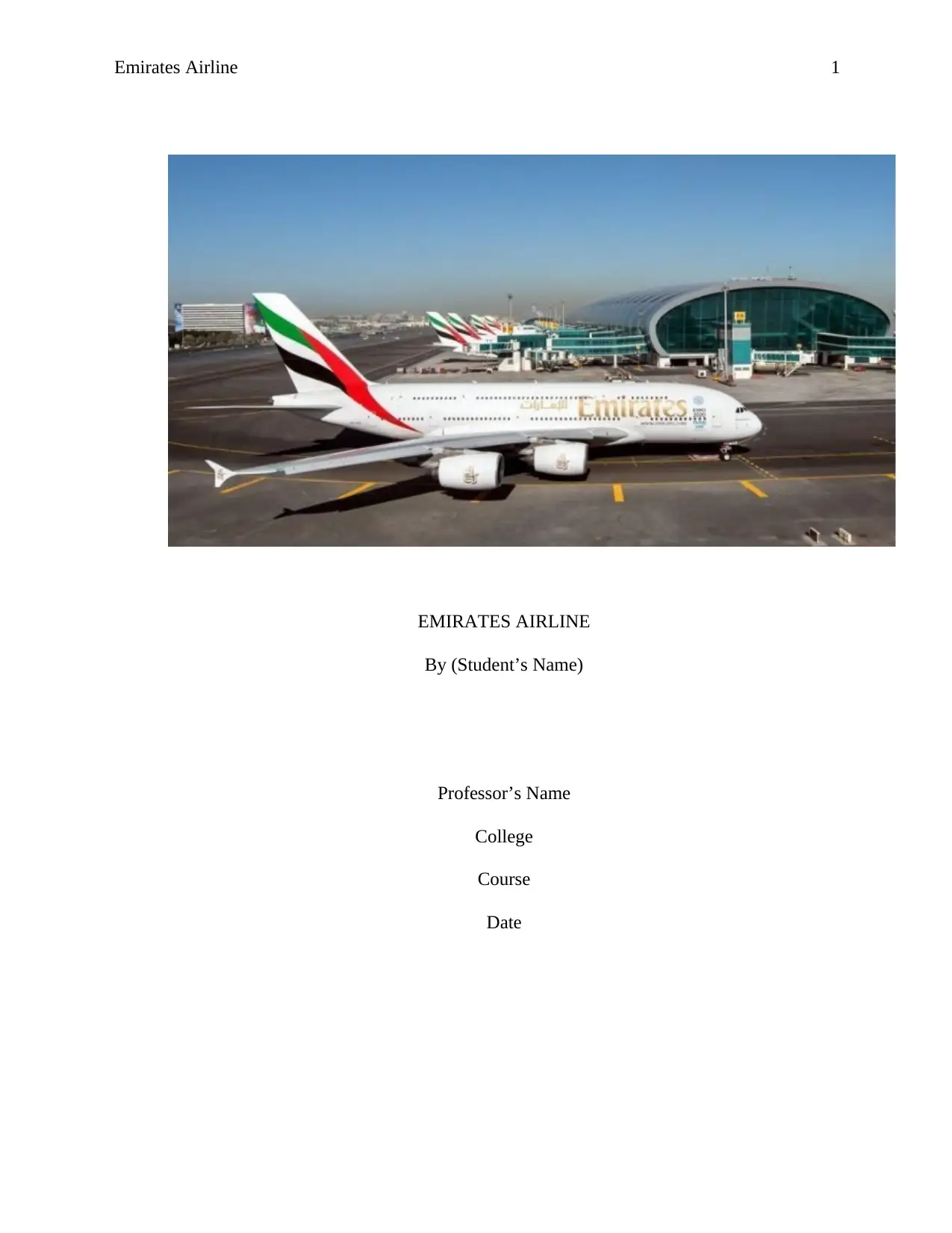
Emirates Airline 1
EMIRATES AIRLINE
By (Student’s Name)
Professor’s Name
College
Course
Date
EMIRATES AIRLINE
By (Student’s Name)
Professor’s Name
College
Course
Date
Paraphrase This Document
Need a fresh take? Get an instant paraphrase of this document with our AI Paraphraser
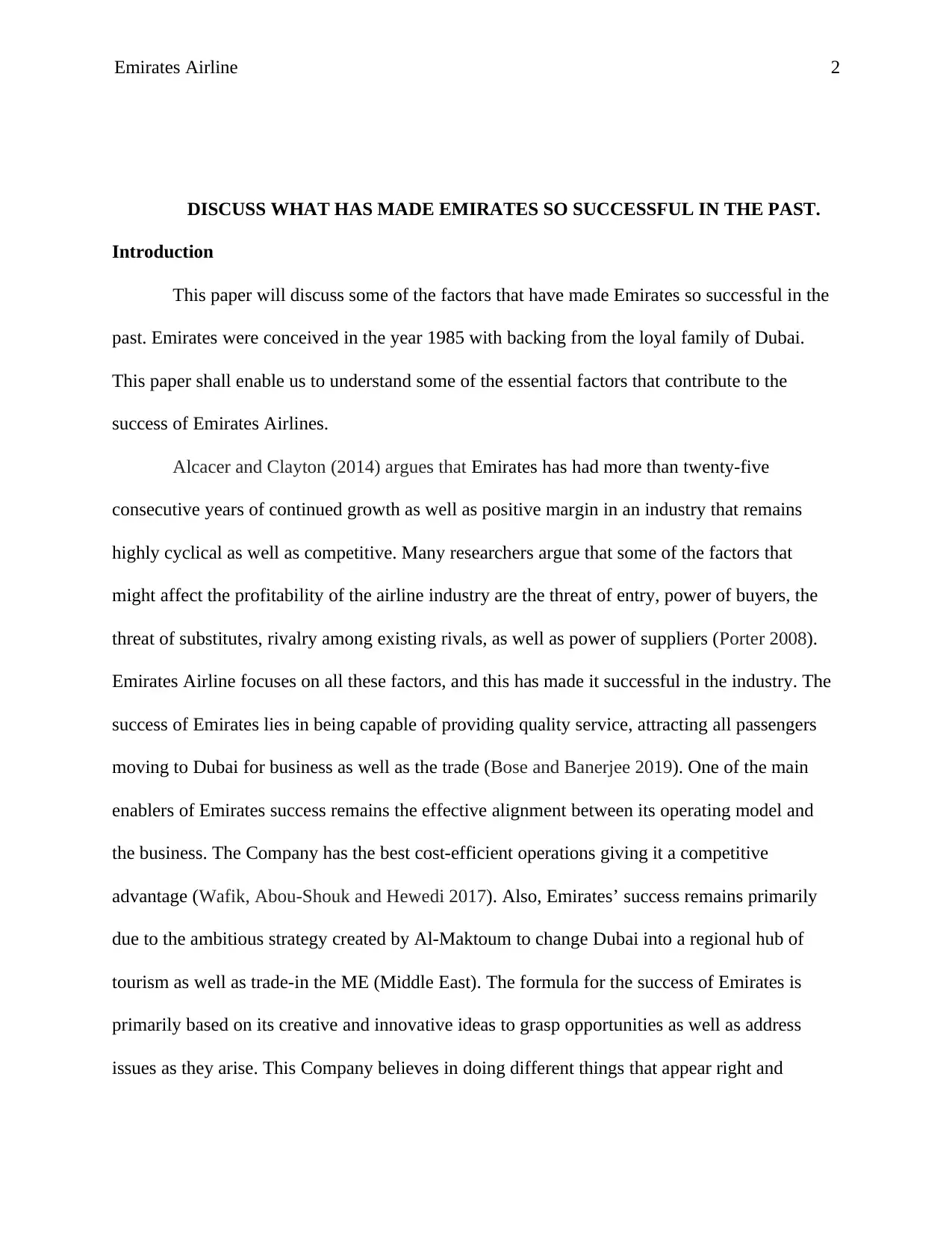
Emirates Airline 2
DISCUSS WHAT HAS MADE EMIRATES SO SUCCESSFUL IN THE PAST.
Introduction
This paper will discuss some of the factors that have made Emirates so successful in the
past. Emirates were conceived in the year 1985 with backing from the loyal family of Dubai.
This paper shall enable us to understand some of the essential factors that contribute to the
success of Emirates Airlines.
Alcacer and Clayton (2014) argues that Emirates has had more than twenty-five
consecutive years of continued growth as well as positive margin in an industry that remains
highly cyclical as well as competitive. Many researchers argue that some of the factors that
might affect the profitability of the airline industry are the threat of entry, power of buyers, the
threat of substitutes, rivalry among existing rivals, as well as power of suppliers (Porter 2008).
Emirates Airline focuses on all these factors, and this has made it successful in the industry. The
success of Emirates lies in being capable of providing quality service, attracting all passengers
moving to Dubai for business as well as the trade (Bose and Banerjee 2019). One of the main
enablers of Emirates success remains the effective alignment between its operating model and
the business. The Company has the best cost-efficient operations giving it a competitive
advantage (Wafik, Abou-Shouk and Hewedi 2017). Also, Emirates’ success remains primarily
due to the ambitious strategy created by Al-Maktoum to change Dubai into a regional hub of
tourism as well as trade-in the ME (Middle East). The formula for the success of Emirates is
primarily based on its creative and innovative ideas to grasp opportunities as well as address
issues as they arise. This Company believes in doing different things that appear right and
DISCUSS WHAT HAS MADE EMIRATES SO SUCCESSFUL IN THE PAST.
Introduction
This paper will discuss some of the factors that have made Emirates so successful in the
past. Emirates were conceived in the year 1985 with backing from the loyal family of Dubai.
This paper shall enable us to understand some of the essential factors that contribute to the
success of Emirates Airlines.
Alcacer and Clayton (2014) argues that Emirates has had more than twenty-five
consecutive years of continued growth as well as positive margin in an industry that remains
highly cyclical as well as competitive. Many researchers argue that some of the factors that
might affect the profitability of the airline industry are the threat of entry, power of buyers, the
threat of substitutes, rivalry among existing rivals, as well as power of suppliers (Porter 2008).
Emirates Airline focuses on all these factors, and this has made it successful in the industry. The
success of Emirates lies in being capable of providing quality service, attracting all passengers
moving to Dubai for business as well as the trade (Bose and Banerjee 2019). One of the main
enablers of Emirates success remains the effective alignment between its operating model and
the business. The Company has the best cost-efficient operations giving it a competitive
advantage (Wafik, Abou-Shouk and Hewedi 2017). Also, Emirates’ success remains primarily
due to the ambitious strategy created by Al-Maktoum to change Dubai into a regional hub of
tourism as well as trade-in the ME (Middle East). The formula for the success of Emirates is
primarily based on its creative and innovative ideas to grasp opportunities as well as address
issues as they arise. This Company believes in doing different things that appear right and
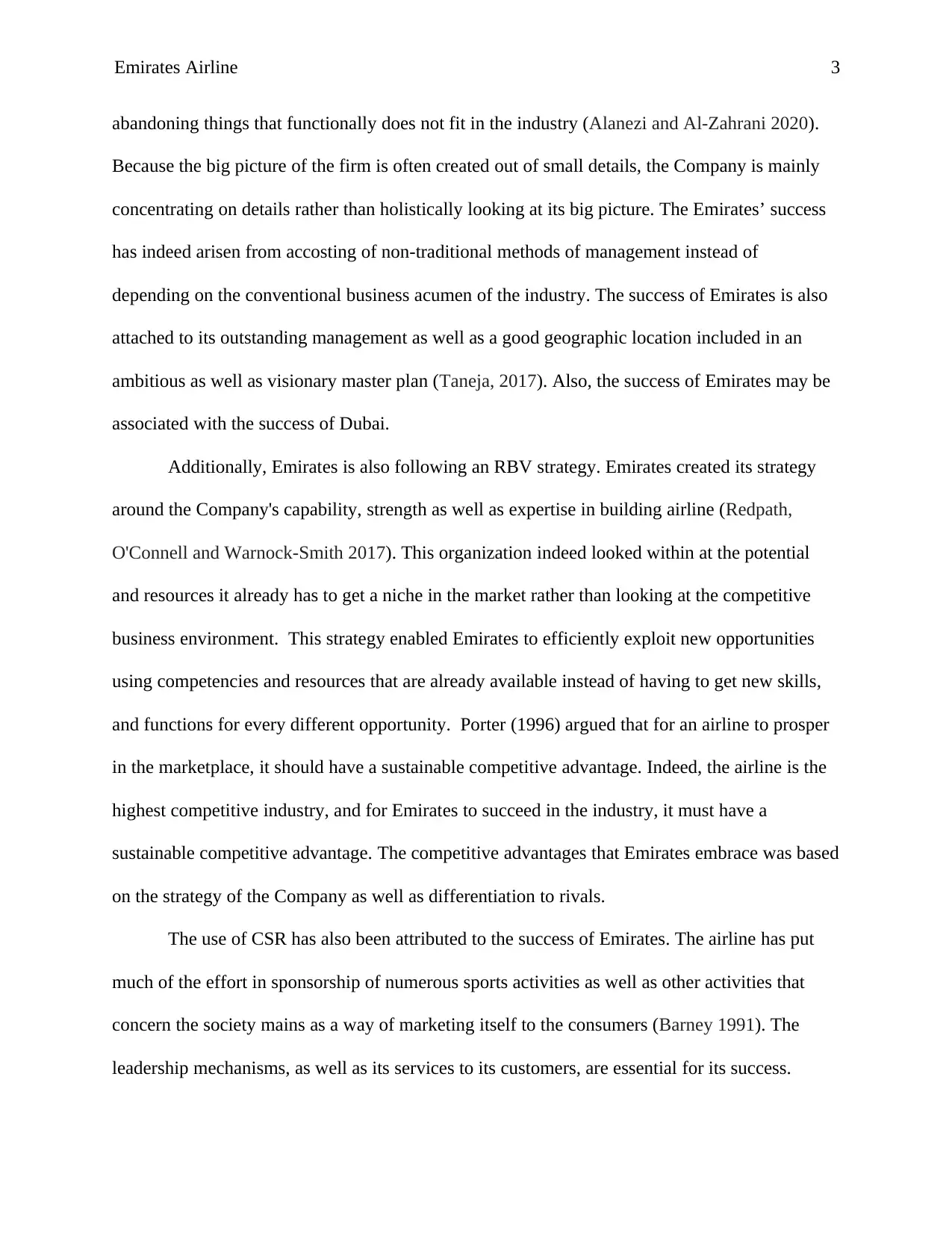
Emirates Airline 3
abandoning things that functionally does not fit in the industry (Alanezi and Al-Zahrani 2020).
Because the big picture of the firm is often created out of small details, the Company is mainly
concentrating on details rather than holistically looking at its big picture. The Emirates’ success
has indeed arisen from accosting of non-traditional methods of management instead of
depending on the conventional business acumen of the industry. The success of Emirates is also
attached to its outstanding management as well as a good geographic location included in an
ambitious as well as visionary master plan (Taneja, 2017). Also, the success of Emirates may be
associated with the success of Dubai.
Additionally, Emirates is also following an RBV strategy. Emirates created its strategy
around the Company's capability, strength as well as expertise in building airline (Redpath,
O'Connell and Warnock-Smith 2017). This organization indeed looked within at the potential
and resources it already has to get a niche in the market rather than looking at the competitive
business environment. This strategy enabled Emirates to efficiently exploit new opportunities
using competencies and resources that are already available instead of having to get new skills,
and functions for every different opportunity. Porter (1996) argued that for an airline to prosper
in the marketplace, it should have a sustainable competitive advantage. Indeed, the airline is the
highest competitive industry, and for Emirates to succeed in the industry, it must have a
sustainable competitive advantage. The competitive advantages that Emirates embrace was based
on the strategy of the Company as well as differentiation to rivals.
The use of CSR has also been attributed to the success of Emirates. The airline has put
much of the effort in sponsorship of numerous sports activities as well as other activities that
concern the society mains as a way of marketing itself to the consumers (Barney 1991). The
leadership mechanisms, as well as its services to its customers, are essential for its success.
abandoning things that functionally does not fit in the industry (Alanezi and Al-Zahrani 2020).
Because the big picture of the firm is often created out of small details, the Company is mainly
concentrating on details rather than holistically looking at its big picture. The Emirates’ success
has indeed arisen from accosting of non-traditional methods of management instead of
depending on the conventional business acumen of the industry. The success of Emirates is also
attached to its outstanding management as well as a good geographic location included in an
ambitious as well as visionary master plan (Taneja, 2017). Also, the success of Emirates may be
associated with the success of Dubai.
Additionally, Emirates is also following an RBV strategy. Emirates created its strategy
around the Company's capability, strength as well as expertise in building airline (Redpath,
O'Connell and Warnock-Smith 2017). This organization indeed looked within at the potential
and resources it already has to get a niche in the market rather than looking at the competitive
business environment. This strategy enabled Emirates to efficiently exploit new opportunities
using competencies and resources that are already available instead of having to get new skills,
and functions for every different opportunity. Porter (1996) argued that for an airline to prosper
in the marketplace, it should have a sustainable competitive advantage. Indeed, the airline is the
highest competitive industry, and for Emirates to succeed in the industry, it must have a
sustainable competitive advantage. The competitive advantages that Emirates embrace was based
on the strategy of the Company as well as differentiation to rivals.
The use of CSR has also been attributed to the success of Emirates. The airline has put
much of the effort in sponsorship of numerous sports activities as well as other activities that
concern the society mains as a way of marketing itself to the consumers (Barney 1991). The
leadership mechanisms, as well as its services to its customers, are essential for its success.
⊘ This is a preview!⊘
Do you want full access?
Subscribe today to unlock all pages.

Trusted by 1+ million students worldwide
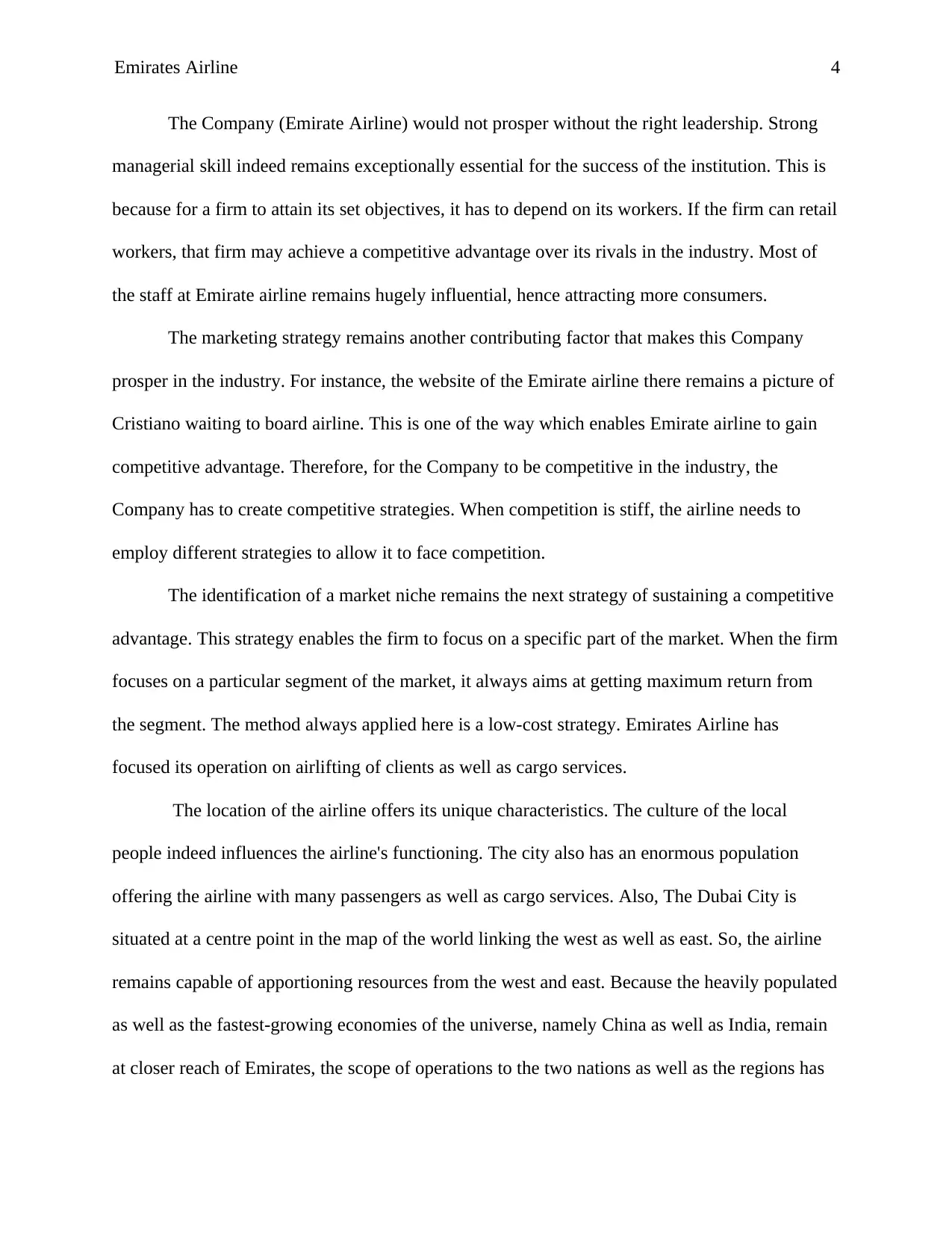
Emirates Airline 4
The Company (Emirate Airline) would not prosper without the right leadership. Strong
managerial skill indeed remains exceptionally essential for the success of the institution. This is
because for a firm to attain its set objectives, it has to depend on its workers. If the firm can retail
workers, that firm may achieve a competitive advantage over its rivals in the industry. Most of
the staff at Emirate airline remains hugely influential, hence attracting more consumers.
The marketing strategy remains another contributing factor that makes this Company
prosper in the industry. For instance, the website of the Emirate airline there remains a picture of
Cristiano waiting to board airline. This is one of the way which enables Emirate airline to gain
competitive advantage. Therefore, for the Company to be competitive in the industry, the
Company has to create competitive strategies. When competition is stiff, the airline needs to
employ different strategies to allow it to face competition.
The identification of a market niche remains the next strategy of sustaining a competitive
advantage. This strategy enables the firm to focus on a specific part of the market. When the firm
focuses on a particular segment of the market, it always aims at getting maximum return from
the segment. The method always applied here is a low-cost strategy. Emirates Airline has
focused its operation on airlifting of clients as well as cargo services.
The location of the airline offers its unique characteristics. The culture of the local
people indeed influences the airline's functioning. The city also has an enormous population
offering the airline with many passengers as well as cargo services. Also, The Dubai City is
situated at a centre point in the map of the world linking the west as well as east. So, the airline
remains capable of apportioning resources from the west and east. Because the heavily populated
as well as the fastest-growing economies of the universe, namely China as well as India, remain
at closer reach of Emirates, the scope of operations to the two nations as well as the regions has
The Company (Emirate Airline) would not prosper without the right leadership. Strong
managerial skill indeed remains exceptionally essential for the success of the institution. This is
because for a firm to attain its set objectives, it has to depend on its workers. If the firm can retail
workers, that firm may achieve a competitive advantage over its rivals in the industry. Most of
the staff at Emirate airline remains hugely influential, hence attracting more consumers.
The marketing strategy remains another contributing factor that makes this Company
prosper in the industry. For instance, the website of the Emirate airline there remains a picture of
Cristiano waiting to board airline. This is one of the way which enables Emirate airline to gain
competitive advantage. Therefore, for the Company to be competitive in the industry, the
Company has to create competitive strategies. When competition is stiff, the airline needs to
employ different strategies to allow it to face competition.
The identification of a market niche remains the next strategy of sustaining a competitive
advantage. This strategy enables the firm to focus on a specific part of the market. When the firm
focuses on a particular segment of the market, it always aims at getting maximum return from
the segment. The method always applied here is a low-cost strategy. Emirates Airline has
focused its operation on airlifting of clients as well as cargo services.
The location of the airline offers its unique characteristics. The culture of the local
people indeed influences the airline's functioning. The city also has an enormous population
offering the airline with many passengers as well as cargo services. Also, The Dubai City is
situated at a centre point in the map of the world linking the west as well as east. So, the airline
remains capable of apportioning resources from the west and east. Because the heavily populated
as well as the fastest-growing economies of the universe, namely China as well as India, remain
at closer reach of Emirates, the scope of operations to the two nations as well as the regions has
Paraphrase This Document
Need a fresh take? Get an instant paraphrase of this document with our AI Paraphraser
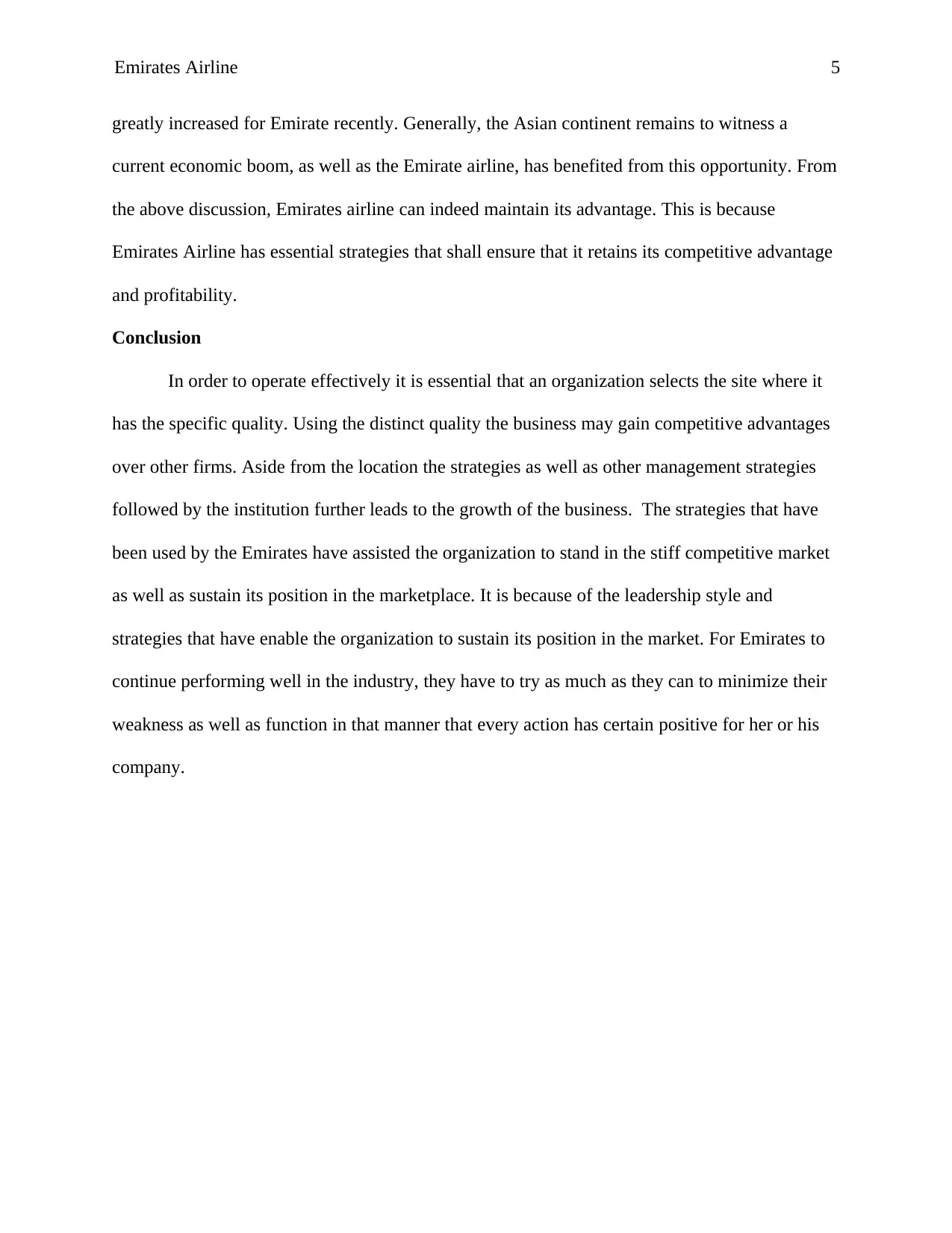
Emirates Airline 5
greatly increased for Emirate recently. Generally, the Asian continent remains to witness a
current economic boom, as well as the Emirate airline, has benefited from this opportunity. From
the above discussion, Emirates airline can indeed maintain its advantage. This is because
Emirates Airline has essential strategies that shall ensure that it retains its competitive advantage
and profitability.
Conclusion
In order to operate effectively it is essential that an organization selects the site where it
has the specific quality. Using the distinct quality the business may gain competitive advantages
over other firms. Aside from the location the strategies as well as other management strategies
followed by the institution further leads to the growth of the business. The strategies that have
been used by the Emirates have assisted the organization to stand in the stiff competitive market
as well as sustain its position in the marketplace. It is because of the leadership style and
strategies that have enable the organization to sustain its position in the market. For Emirates to
continue performing well in the industry, they have to try as much as they can to minimize their
weakness as well as function in that manner that every action has certain positive for her or his
company.
greatly increased for Emirate recently. Generally, the Asian continent remains to witness a
current economic boom, as well as the Emirate airline, has benefited from this opportunity. From
the above discussion, Emirates airline can indeed maintain its advantage. This is because
Emirates Airline has essential strategies that shall ensure that it retains its competitive advantage
and profitability.
Conclusion
In order to operate effectively it is essential that an organization selects the site where it
has the specific quality. Using the distinct quality the business may gain competitive advantages
over other firms. Aside from the location the strategies as well as other management strategies
followed by the institution further leads to the growth of the business. The strategies that have
been used by the Emirates have assisted the organization to stand in the stiff competitive market
as well as sustain its position in the marketplace. It is because of the leadership style and
strategies that have enable the organization to sustain its position in the market. For Emirates to
continue performing well in the industry, they have to try as much as they can to minimize their
weakness as well as function in that manner that every action has certain positive for her or his
company.
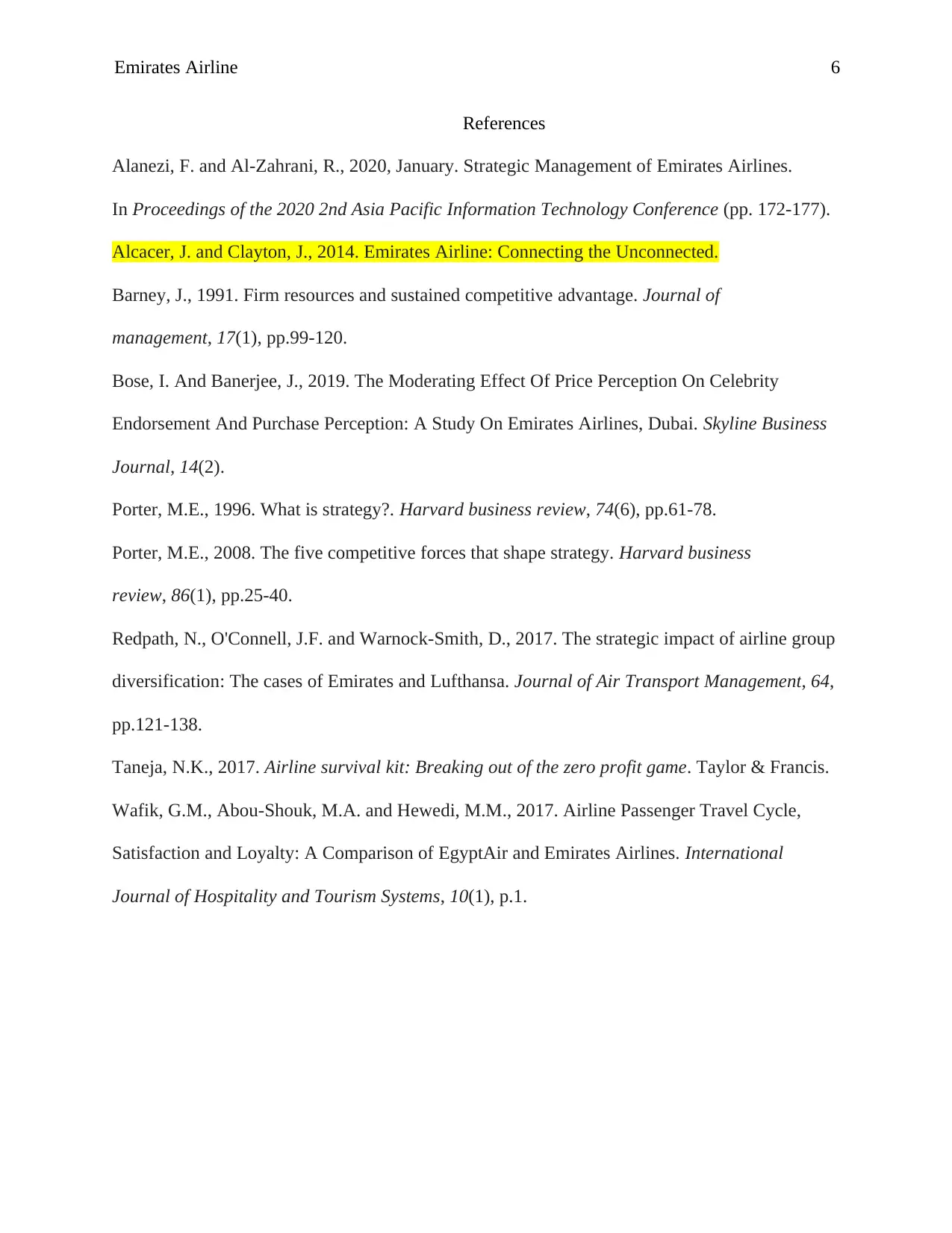
Emirates Airline 6
References
Alanezi, F. and Al-Zahrani, R., 2020, January. Strategic Management of Emirates Airlines.
In Proceedings of the 2020 2nd Asia Pacific Information Technology Conference (pp. 172-177).
Alcacer, J. and Clayton, J., 2014. Emirates Airline: Connecting the Unconnected.
Barney, J., 1991. Firm resources and sustained competitive advantage. Journal of
management, 17(1), pp.99-120.
Bose, I. And Banerjee, J., 2019. The Moderating Effect Of Price Perception On Celebrity
Endorsement And Purchase Perception: A Study On Emirates Airlines, Dubai. Skyline Business
Journal, 14(2).
Porter, M.E., 1996. What is strategy?. Harvard business review, 74(6), pp.61-78.
Porter, M.E., 2008. The five competitive forces that shape strategy. Harvard business
review, 86(1), pp.25-40.
Redpath, N., O'Connell, J.F. and Warnock-Smith, D., 2017. The strategic impact of airline group
diversification: The cases of Emirates and Lufthansa. Journal of Air Transport Management, 64,
pp.121-138.
Taneja, N.K., 2017. Airline survival kit: Breaking out of the zero profit game. Taylor & Francis.
Wafik, G.M., Abou-Shouk, M.A. and Hewedi, M.M., 2017. Airline Passenger Travel Cycle,
Satisfaction and Loyalty: A Comparison of EgyptAir and Emirates Airlines. International
Journal of Hospitality and Tourism Systems, 10(1), p.1.
References
Alanezi, F. and Al-Zahrani, R., 2020, January. Strategic Management of Emirates Airlines.
In Proceedings of the 2020 2nd Asia Pacific Information Technology Conference (pp. 172-177).
Alcacer, J. and Clayton, J., 2014. Emirates Airline: Connecting the Unconnected.
Barney, J., 1991. Firm resources and sustained competitive advantage. Journal of
management, 17(1), pp.99-120.
Bose, I. And Banerjee, J., 2019. The Moderating Effect Of Price Perception On Celebrity
Endorsement And Purchase Perception: A Study On Emirates Airlines, Dubai. Skyline Business
Journal, 14(2).
Porter, M.E., 1996. What is strategy?. Harvard business review, 74(6), pp.61-78.
Porter, M.E., 2008. The five competitive forces that shape strategy. Harvard business
review, 86(1), pp.25-40.
Redpath, N., O'Connell, J.F. and Warnock-Smith, D., 2017. The strategic impact of airline group
diversification: The cases of Emirates and Lufthansa. Journal of Air Transport Management, 64,
pp.121-138.
Taneja, N.K., 2017. Airline survival kit: Breaking out of the zero profit game. Taylor & Francis.
Wafik, G.M., Abou-Shouk, M.A. and Hewedi, M.M., 2017. Airline Passenger Travel Cycle,
Satisfaction and Loyalty: A Comparison of EgyptAir and Emirates Airlines. International
Journal of Hospitality and Tourism Systems, 10(1), p.1.
⊘ This is a preview!⊘
Do you want full access?
Subscribe today to unlock all pages.

Trusted by 1+ million students worldwide
1 out of 6
Related Documents
Your All-in-One AI-Powered Toolkit for Academic Success.
+13062052269
info@desklib.com
Available 24*7 on WhatsApp / Email
![[object Object]](/_next/static/media/star-bottom.7253800d.svg)
Unlock your academic potential
Copyright © 2020–2025 A2Z Services. All Rights Reserved. Developed and managed by ZUCOL.





